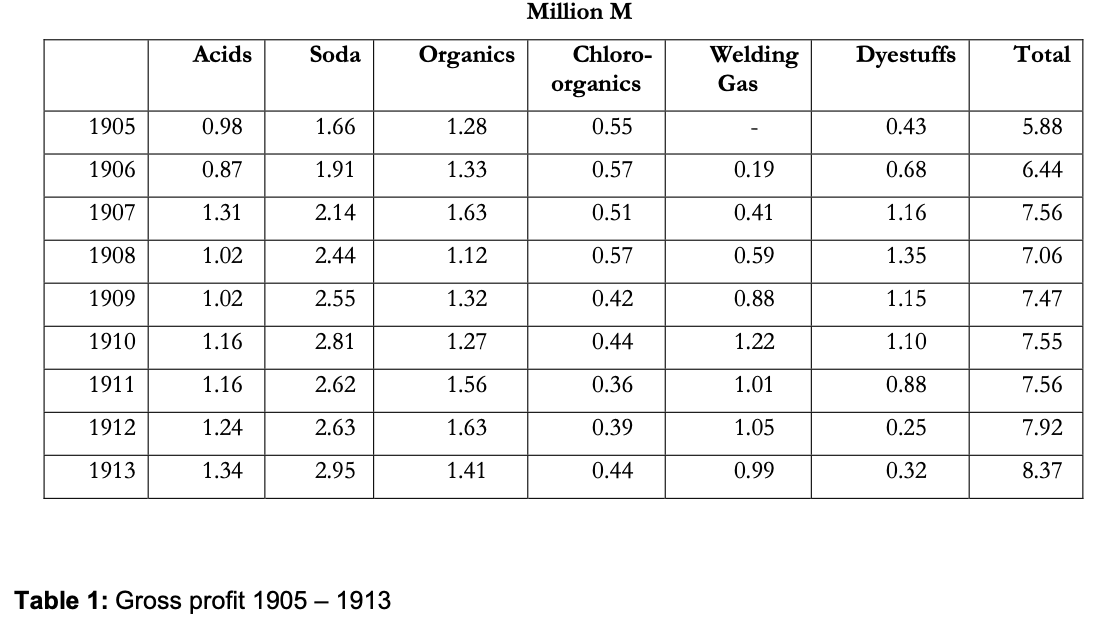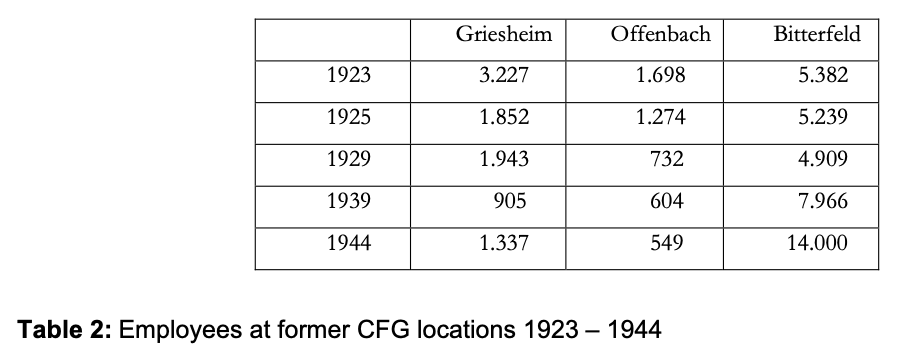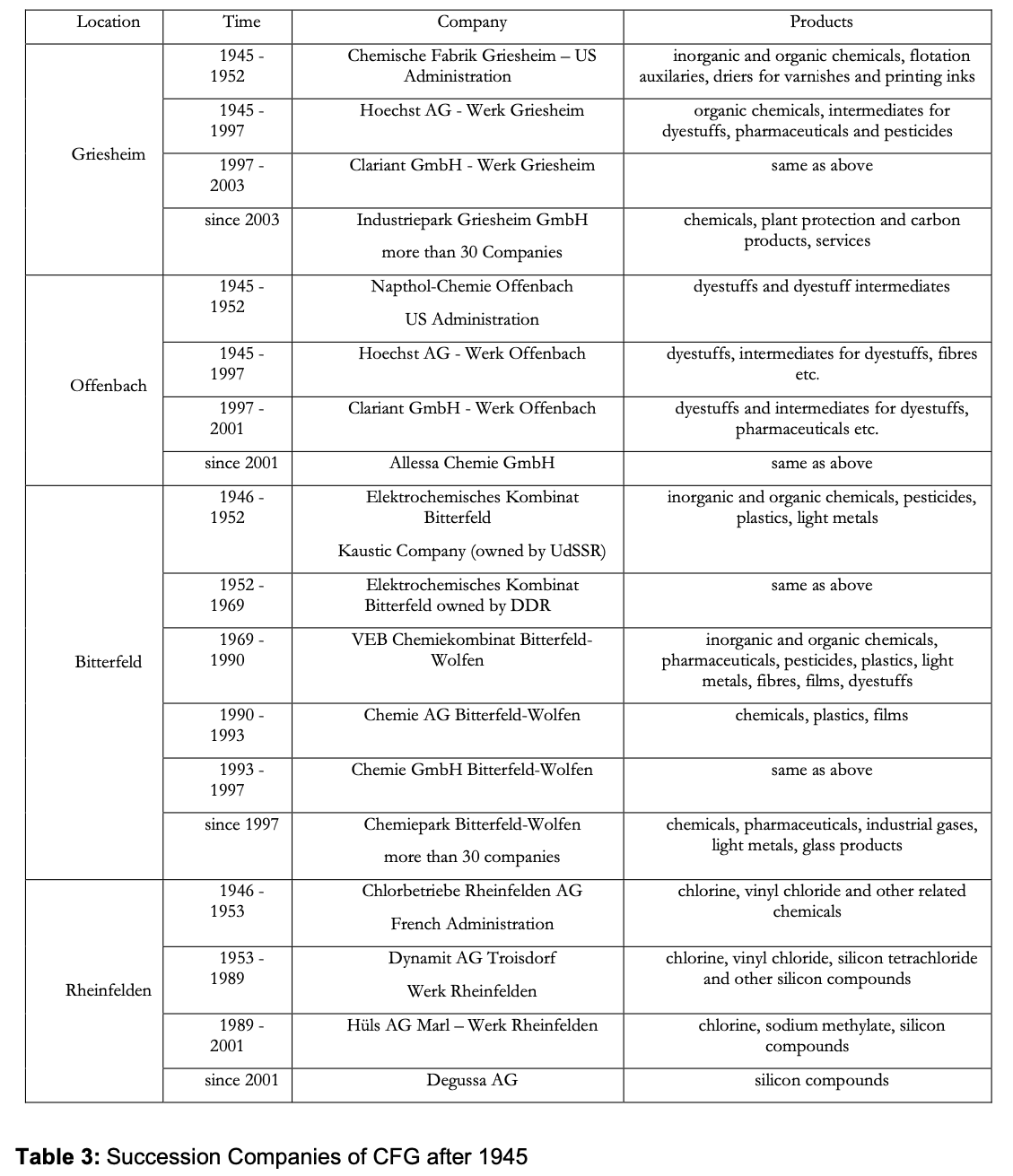Chemische Fabrik Griesheim – Pioneer of Electrochemistry
Abstract: This paper gives a brief survey on the history and the strategies of Chemische Fabrik Griesheim of Frankfurt on the Main. After the foundation in 1856, it had been a middle-sized chemical company manufacturing fertilizers, mineral acids and soda. Due to important innovations, the enterprise developed to a leading producer of heavy chemicals at the end of the 19th century. To improve profitability, it acquired a dyestuff company and joined IG Farben Trust in 1925. After World War II, its activities and plants became parts of other corporations. Most of them are still operating.
Introduction
The emergence of the German dyestuff manufactures in the 1860s had led to a blossoming time of the chemical industry at the end of the 19th century. Before that time, there existed only middle-sized firms producing soda and mineral acids. Chemische Fabrik Griesheim (CFG) of Frankfort on the Main, which celebrates its 150th anniversary this year, belonged to these companies. However, it existed as independent enterprise only up to 1925, when it joined the huge IG Farben trust. Before World War I it had developed into one of the biggest chemical companies in Germany. According to turnover and number of employees it ranged on fourth place behind the “big three” BASF, Bayer and Hoechst. When the Allies disintegrated the IG Farben Industry in 1945, CFG could not be established again, because its biggest production facilities were located in East Germany under the administration of the Soviet Union.
From the Foundation to First Innovation
Ludwig Baist, the founder of CFG, had been inspired by the ideas of the great chemist Justus von Liebig, who published his theory of plant nutrition and mineral fertilization in the early 1840s. The introduction of mineral fertilizers into the market, however, presented more problems than expected. Therefore, one added soda to the product range. In the following two decades CFG developed into one of the approximately 20 chemical companies in Germany manufacturing soda, mineral acids and other chemicals. After 1880 the situation changed dramatically for two reasons: 1. Dyestuff manufacturers, big customers of acids, started their own acid production and 2. the new Solvay process for soda manufacturing turned out to be superior to the Leblanc method, used by CFG and the other soda producers. In 1884, CFG took the opportunity to join a syndicate of soda manufacturers, which aimed to exploit a patent for the production of caustic soda and chlorine by electrolysis of salt. For this complete new technology no experience existed in the chemical industry at that time. When some experiments in the laboratory looked promising, the CFG took the initiative to build a pilot plant on their Griesheim site. Many obstacles had to be overcome: No electrodes were available which could stand the reaction conditions. The commercial generators did not prove suitable for the electrochemical process. But the plant manager Ignaz Stroof did not give up. In 1890 he could announce that the first production unit in the world for the electrolysis of salt was running successfully.
Growth and Expansion
The cost of electricity, however, was too high at the Griesheim plant, because one had to buy the expensive pit coal of the Ruhr region. Since there existed large deposits of cheap brown coal in Middle Germany, CFG decided to erect a plant with bigger production units in Bitterfeld. Within a very short time CFG was able to supply the market with its new products at reasonable prices. Elektrochemische Werke, a company founded by Walter Rathenau, had also built an electrolysis plant at Bitterfeld. It was not able to compete, gave up and offered CFG to lease their facilities. This put Griesheim within a few years in a position to become the leading supplier of caustic soda, potassium and chlorine
The chlorine-alkali process not only produces these two components but a third one: hydrogen. One tried to use it for heating or even for filling Zeppelin airships. The Griesheim engineer Ernst Wiss developed a burner for iron welding using a mixture of hydrogen and compressed oxygen. Although the management of CFG was reluctant in the beginning, the new process of autogenous welding was successfully introduced in the market. Using a surplus of oxygen the method could be used for cutting metal. For better promotion CFG started cooperation with Air Liquide Company of France, a supplier of oxygen and oxygen production units. Several oxygen facilities were built close to the iron industry in the Rhineland and other regions. As by-products of oxygen fabrication noble gases, especially Argon, Neon and Helium were obtained. In order to find applications for these gases, the Griesheim cientists experimented with luminophors. In 1913 the first neon lamp was produced in the laboratory.
The production of electrodes for the chloralkali electrolysis also developed to a special field of activities. Electrodes were first obtained by pressing a mixture of crashed coal and tar and heating to 1300°C. The manufacturing of graphite electrodes was taken up in 1916. Besides for electrodes the material can also be used for thermal and corrosion resistant equipment and lining.
Although the main effort concentrated after 1890 on the chloralkali electrolysis and related fields, the other products had not been neglected. The loss of acid sales to the dyestuff companies could be substituted by deliveries to explosive manufacturers. Since Alfred Nobel had invented dynamite, the requirement of sulphuric and nitric acid had picked up. Because the transportation of larger quantities of acids presented problems at that time, CFG erected acid plants close to explosive and gun powder producers in Spandau near Berlin and Küppersteg in the Cologne area.
Chlorine and sodium or potassium hydroxides are simultaneously formed by the electrolysis in a constant ratio. The requirements of soda usually exceeded those of chlorine. In the beginning, chlorine was converted in chloride of lime, which was used in large quantities as disinfectant and for bleaching. In addition, CFG founded in 1882 the subsidiary Mainthal for the manufacturing of organic chlorine compounds. The product range comprised chloroacetic acid, chlorobenzene, benzoic acid, tetrachloromethane, chloral hydrate and others. These compounds were intermediates for pharmaceuticals, dyestuffs and other chemicals or were used as solvents.
The experience gained by chloralkali electrolysis lead CFG to another activity of electrochemical technology. For the manufacture of pure phosphorous, an electric oven had to be designed. In 1895 the first amounts of phosphorous were produced in a pilot plant by heating a mixture of phosphates, coal and sand. Since requirements for matches, artificial fog and metallurgy increased, a larger unit was built in Bitterfeld in 1902. There was also research work done for gaining light metals by electro thermal processes. The plans to erect an aluminium factory were dropped in 1906 because of low market prices. The manufacturing of magnesium looked more promising. Due to its low weight the metal was of interest for the arising aviation industry. Since further processing of magnesium was difficult, CFG tried to develop better-suited alloys of magnesium and other metals. The efforts resulted in an alloy called “Elektron”, which in the following years was widely used for airplane and airship assembling.
Unsatisfying Profitability
Sales increased in 1885, when CFG started to do research in innovative products, from 4,6 Million M to 48,3 Million M in 1905, but in the same period net profits did not keep up with this expansion. They dropped from 8,5 % to 6,2% of turnover. Consequently, the company could only disburse 10 – 16 % dividend to its stockholders compared to 25 – 35 %, which the dyestuff companies were able to pay. For this reason, the management of CFG was looking for an acquisition of dyestuff manufacturers since the beginning of the 20th century. In 1905, the company was offered to buy the Oehler dyestuff factory in Offenbach. The company existed already since 1843, but belonged to the smaller sized dyestuff producers. Sales amounted to 7,5 Million M in 1905 and consisted of dyestuffs and dyestuff intermediates, mainly aniline. However, the acquisition came very late. Because of increasing competition, the big dyestuff companies had formed alliances in 1904. Since CFG put a lot of effort and money in research, sales and profits picked up in the beginning. After 1908 competition became tougher. One was forced to switch to a low price strategy. As shown below, earnings went down considerably.

The decline of profits from 1908 to 1910 was due to a light recession in Germany. The soda business was not affected, but competition was growing in this field, too. Chlorine, chloride of lime and other products of electrolysis also belonged to the soda group. Organics comprised mainly aniline and related goods.
The War and its Consequences
In 1914, at the outbreak of World War I, the number of employees of CFG amounted to 4.708 blue-collar and 950 white-collar workers. The Griesheim factory counted 2.500 employees and the Bitterfeld works approximately 1.500. The others were working at the acid and oxygen plants and at Rheinfelden, a small electrochemical factory, which CFG had also leased from Elektrochemische Werke. The factory was located at the Swiss border and was using hydro-electric power of the Rhine.
Since Griesheim had already manufactured explosives before 1914, it became one of the largest suppliers of explosives in the course of the war. Besides picric acid and trinitrotoluene other explosives like ammonium nitrate, chlorates and perchlorates were manufactured. The armed forces also ordered phosphorous and magnesium. Because there was no aluminium production in Germany, CFG was asked by the government to join an enterprise for the manufacturing of the light metal. The state was holding 50 % of the shares of the new founded “Vereinigte Aluminiumwerke”, CFG and Metallgesellschaft of Frankfurt 25 % each. Until 1918, plants were built in Rummelsburg near Berlin, Horrem/Rhineland and Bitterfeld.
Owing to the increasing fabrication for military purposes, production of civil goods had to be reduced. But still research in non-military fields was possible and resulted in a spectacular invention. Before the war, CFG had experimented with acetylene derivatives, e.g. vinyl acetate and vinyl chloride. When working with these compounds, Fritz Klatte had observed in 1912 that resins were formed when exposed to light. The first polymerisation of polyvinylchloride and polyvinyl acetate had been achieved in the Griesheim laboratories! The new products became of interest during the war as replacement for natural resins, which could not be imported anymore. But due to the difficult process and other priorities only smaller amounts of polymers were manufactured until 1918 in a pilot plant. As soon as natural resins became available again after the war, there was no demand anymore for polyvinyl plastics. It lasted until the late nineteen twenties before pilot plant manufacturing was taken up again at Bitterfeld and Ludwigshafen. After World War II polyvinylchloride (PVC) became the largest plastic material in the world.
In 1916 another effort was made by the big German dyestuff companies to come to a closer cooperation. As these firms were depending much on exports, they feared a much tougher competition on the world market when the war would be over. On the other hand nobody wanted to give up its independence. Hence in August 1916 the IG Farben Association was founded. CFG joined the alliance as of January 1917. The goal of the association was cooperation and mutual information about sales, new products, expansion plans etc.
After 1918 the need of all kind of goods, which had been accumulated during wartime had to be satisfied. This resulted in a boom of the chemical and other industries. Investment increased, CFG erected new buildings at their locations and modernized equipment. But soon it turned out that the economic recovery would not last. The inflation was eating up the assets of the people and unemployment increased considerably. After the war more than 15.000 people had been employed at the CFG factories. In 1920 the number decreased to 11.200 and in 1924 to 9.700. Within the IG Farben Association negotiations were underway to transform the alliance to a big joint- stock company. The treaty of the IG Farben AG was signed in October 1925 and became effective January 1926. The management of CFG hesitated first to enter the corporation, because its portfolio did not fit well into the business dominated by the dyestuff companies. On the other hand it regarded itself as a dyestuff producer. So finally CFG also signed and ceased to be an independent enterprise.
The position of CFG within the management of the IG Farben Corporation was not very influential, as its activities did not belong to the strong points of strategy. The Griesheim factory had a hard time to survive. Its facilities for soda and acids were transferred to Bitterfeld or had become obsolete. In the intermediates section the Bayer and BASF plants often had a stronger position. The situation at Bitterfeld was more favourable. The electrolytic equipment was modernized and enlarged. Larger phosphorous ovens were installed; research in the light metal alloys field was intensified. In 1927 a pilot plant for the manufacture of Polyvinylchloride (PVC) was erected, three years later small production facilities. The dyestuff plant at Offenbach suffered most after the IG Farben merger. Manufacturing of many products was discontinued, some departments totally closed due to either streamlining of the assortment or more profitable fabrication conditions at other sites of IG Farben. Luckily in 1912 a new two-component dyeing process had been discovered at the Offenbach research laboratories. The so-called Naphthol AS components were successfully introduced into the market after the war. Increasing sales of Naphthol AS goods ensured the survival of the Offenbach factory.
The Bitterfeld works grew most also during World War II, because light metals but also plastics, phosphorous and chlorine compounds were needed by the military. The number of employees shows the different development of the former CFGE plants under the IG Farben administration.


After the war Sigri Elektrographit GmbH, a joint venture of Siemens and Hoechst AG, was running the carbon business. In 1991, the company merged with Great Lakes Carbon of USA to form SGL Carbon AG, a leading producer of carbon and graphite goods. A joint venture was also formed by Hoechst AG and Adolf Messer GmbH for the industrial gases and welding products. The shares of Hoechst were sold in 1999 to Messer Industrie GmbH and in 2004, the Messer Group GmbH took over the entire company.
Summary
In the first decades after its foundation, the management of CFG was following a conservative strategy. However, when the company was experencing more and more into difficulties in the 1880s, the executives moved courageously and successfully into a completely new field of chemical technology. They also did not hesitate to relocate the new production to places where conditions were more favourable. After the company had gained a leading position in the heavy chemicals market, it followed up its innovative policy resulting in new gas welding technology, industrial gases and carbon products. Although it took quiet some time to convert the invention of vinyl polymers into economic success, CFG could claim to have produced these polymers on an industrial scale for the first time. Despite its achievements in heavy chemical industry, CFG was not operating as profitable as other chemical firms, manufacturing products that are more sophisticated such as dyestuffs and pharmaceuticals. Therefore, the management of CFG changed its strategy, neglected to update its innovative products and procedures and bought a small dyestuff producer. Nevertheless, the action did not yield the expected result, because the dyestuff market had already passed over its climax, but it paved the way to the merger of CFG into IG Farben Industries.
The name of Chemische Fabrik Griesheim is forgotten, but its tradition is alive in its succession companies and its contribution to basic chemical technology. Finally, CFG has gained merits as main initiator of a new industrial region for chemistry in Middle Germany, called “Chemiedreieck Halle/Merseburg”.
References
Archives Hoechst AG at Histocom GmbH, Frankfurt a.M.-Höchst: Minutes of the board of directors of CFG 1856 – 1925, records of the stockholders meeting, various reports and correspondences (c/2/3/b – c/3/4/a).
Raschen, H., Hofmann, P. (1937), 75 Jahre Chemische Fabrik Griesheim-Elektron, Frankfurt a.M.
Pistor, G. (1958), Hundert Jahre Griesheim 1856 – 1956, Tegernsee.
Wagner, D. (1999), Innovation und Standort, Geschichte und Unternehmensstrategien der Chemischen Fabrik Griesheim 1856 – 1925, Darmstadt.